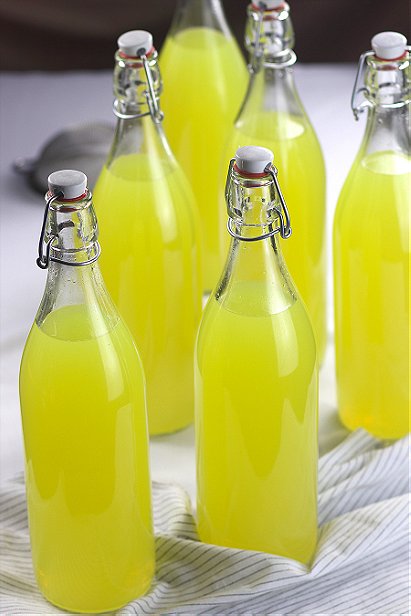Limoncello
Limoncello (Italian pronunciation: [limonˈtʃɛlːo]) is an Italian lemon liqueur mainly produced in Southern Italy, especially in the region around the Gulf of Naples, the Sorrentine Peninsula and the coast of Amalfi, as well as the islands of Procida, Ischia, and Capri. It is also produced in Calabria, Abruzzo, Basilicata, Apulia, Sicily, Sardinia, Liguria, Menton in France, and the Maltese island of Gozo. In northern Italy, the liqueur is often referred to instead as limoncino. It is also a popular homemade liqueur, with various recipes available online and in print.
Traditionally, limoncello is made from the zest of Femminello St. Teresa lemons, also known as Sorrento or Sfusato lemons. Lemon zest, or peels without the pith, is steeped in rectified spirit (most commonly grappa, but vodka may also be used) until the oil is released. The resulting yellow liquid is then mixed with simple syrup. Varying the sugar-to-water ratio and the temperature affects the clarity, viscosity, and flavor. Opaque limoncellos are the result of spontaneous emulsification (otherwise known as the ouzo effect) of the sugar syrup and extracted lemon oils.
Limoncello is traditionally served chilled as an after-dinner digestivo. Along the Amalfi Coast, it is usually served in small ceramic glasses that are also chilled. This tradition has been carried into other parts of Italy. Limoncello is also used to make various cocktails, pastry or ice cream
Traditionally, limoncello is made from the zest of Femminello St. Teresa lemons, also known as Sorrento or Sfusato lemons. Lemon zest, or peels without the pith, is steeped in rectified spirit (most commonly grappa, but vodka may also be used) until the oil is released. The resulting yellow liquid is then mixed with simple syrup. Varying the sugar-to-water ratio and the temperature affects the clarity, viscosity, and flavor. Opaque limoncellos are the result of spontaneous emulsification (otherwise known as the ouzo effect) of the sugar syrup and extracted lemon oils.
Limoncello is traditionally served chilled as an after-dinner digestivo. Along the Amalfi Coast, it is usually served in small ceramic glasses that are also chilled. This tradition has been carried into other parts of Italy. Limoncello is also used to make various cocktails, pastry or ice cream
Tags:
My tags:
Update feed
amongus added this to wanted list 1 year, 7 months ago
psychofaerie added this to Liked list 5 years, 4 months ago
Rylvan posted a video 5 years, 7 months ago
 Login
Login













